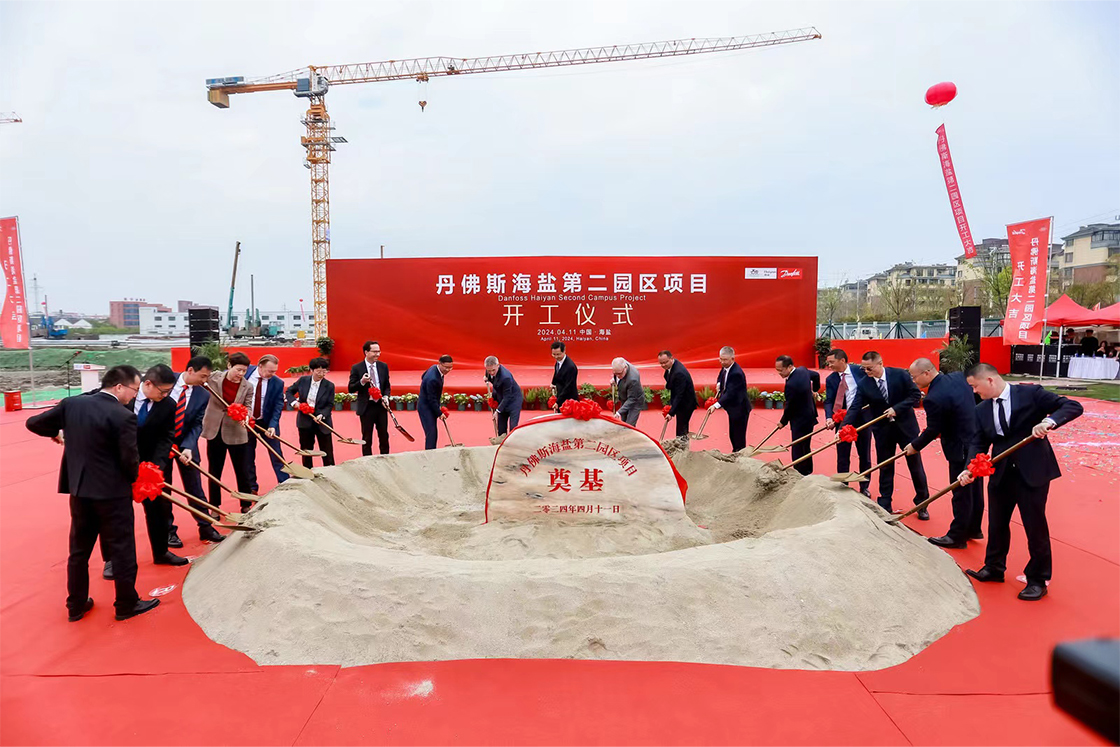Danfoss – Danfoss launches construction to further expand its strong presence in China
Haiyan, China – Danfoss, the Danish multinational engineering group, today announces the beginning of construction to further expand its presence in China at a groundbreaking ceremony co-hosted with the local government.
Danfoss operates eight production and innovation facilities in Haiyan, situated in China’s Zhejiang province. Covering an area of 135,000 sqm, the new campus to be constructed will be one of the biggest production sites in Danfoss’ history.
The new campus will be used to capture the growth potential unleashed by China’s transition to a green, low-carbon economy.
Eric Alström, President, Danfoss Power Solutions, (as a representative of Danfoss’ Group Executive Team) says:”As China continues its transition to a green, low-carbon economy, the Chinese market is becoming increasingly important for our global business success. Over the years, we’ve been investing continuously in the market, especially in capacity, innovation, and digitization as well as state-of-the-art technology production. This expansion project will support our business growth and our transition in China from “Made in China’ to “Created in China.”
Thomas Østrup Møller, Ambassador of Denmark to China; Chen Wei, Party Secretary of Jiaxing City and Wang Suishe, Party Secretary of Haiyan County attended the ceremony together with Eric Alström, President, Danfoss
Power Solutions; Arthur Xu, President of Danfoss China, among other Danfoss executives and guests.
Torben Christensen, Chief Sustainability Officer & Head of Global Services in Danfoss, says:”The new campus will be a perfect showcase for our decarbonization solutions and ‘three-step decarbonization approach’, which has proved to be an effective roadmap for industry to decarbonize their growth quickly and cost-effectively with solutions readily available.”
In line with Danfoss’ commitment to decarbonize global operations by 2030, the campus is being constructed with energy efficiency in focus. The site will operate with Danfoss’ three-step decarbonization approach ‘Reduce, Reuse and Re-source’.
Energy efficient technologies will be applied to keep the energy consumption down, and – where possible – energy will be reused and sourced from renewable sources. Danfoss is negotiating details regarding a long-term green power purchase agreement, aiming to have the campus fully covered with green power when it starts operations in 2025.
The expanded Danfoss footprint will showcase to customers how the company has decarbonized its own operations as well as demonstrate how they can apply the same three-step approach to their own facilities. This will help generate sales and create momentum for business growth over the long term.
The Danfoss Haiyan Campus is an important innovation and manufacturing base in the company’s global footprint, boasting application development centers on par with the company’s campuses in Europe and the United States.
Arthur Xu, President of Danfoss China, says:”The expansion project is a solid step of our committed development in China, especially in the areas of smart manufacturing, innovation, and sustainability. It is also a strategic move driven by close collaboration between Danfoss and the Haiyan government to accelerate the development of green energies and the development of the new quality productive force.”
Thomas Østrup Møller, Ambassador of Denmark to China, says:”Green transition has become very important for China’s development. Danfoss has supported the transition of China for decades by investing in especially Zhejiang, by building state of the art industrial complexes, and by offering the solutions needed to decarbonize China through ’reduce, reuse and re-source’.”
Wang Suishe, Party Secretary of Haiyan County, says:”Haiyan cherishes our cooperation with Danfoss, and we are dedicated to offering high-quality services to the construction of the expansion project and Danfoss’ development.”
The project is expected to be completed in Q2 2025.
SourceDanfoss
EMR Analysis
More information on Danfoss: See the full profile on EMR Executive Services
More information on Kim Fausing (President and Chief Executive Officer, Danfoss): See the full profile on EMR Executive Services
More information on Danfoss Power Solutions: https://www.danfoss.com/en/about-danfoss/our-businesses/power-solutions/ + Danfoss Power Solutions is a world-class provider of mobile hydraulic and electrification products and solutions. It’s not just our name. It’s what we do! Providing power to transform the world in an energy-efficient and sustainable way!
More information on Eric Alström (Member of the Group Executive Team (GET), President, Danfoss Power Solutions, Danfoss): See the full profile on EMR Executive Services
More information on Arthur Xu (President, Danfoss China, Danfoss): See the full profile on EMR Executive Services
More information on the Danfoss Sustainability Strategy: See the full profile on EMR Executive Services
More information on Torben Christensen (Chief Sustainability Officer & Head of Global Services, Danfoss): See the full profile on EMR Executive Services
More information on Thomas Østrup Møller (Ambassador of Denmark, China): https://kina.um.dk/en/about-us/danish-representations-in-china/the-danish-embassy-in-beijing/meet-the-ambassador + https://www.linkedin.com/in/thomas-%C3%B8strup-m%C3%B8ller-71184a19/
More information on Chen Wei (Party Secretary, Jiaxing City, China): N.A.
More information on Wang Suishe (Party Secretary, Haiyan County, China): N.A.
EMR Additional Notes:
- Carbon Dioxide (CO2):
- Primary greenhouse gas emitted through human activities. Carbon dioxide enters the atmosphere through burning fossil fuels (coal, natural gas, and oil), solid waste, trees and other biological materials, and also as a result of certain chemical reactions (e.g., manufacture of cement). Carbon dioxide is removed from the atmosphere (or “sequestered”) when it is absorbed by plants as part of the biological carbon cycle.
- Biogenic Carbon Dioxide (CO2):
- Carbon Dioxide released as a result of the combustion or decomposition of organic material, that is biomass and its derivatives. Examples include carbon dioxide released during the combustion of wood and biogas generated by decomposition.
- Biogenic Carbon Dioxide (CO2) and Carbon Dioxide (CO2) are the same. Scientists differentiate between biogenic carbon (that which is absorbed, stored and emitted by organic matter like soil, trees, plants and grasses) and non-biogenic carbon (that found in all other sources, most notably in fossil fuels like oil, coal and gas).
- Carbon Capture and Storage (CCS):
- CCS involves the capture of carbon dioxide (CO2) emissions from industrial processes, such as steel and cement production, or from the burning of fossil fuels in power generation. This carbon is then transported from where it was produced, via ship or in a pipeline, and stored deep underground in geological formations.
- CCS projects typically target 90 percent efficiency, meaning that 90 percent of the carbon dioxide from the power plant will be captured and stored.
- Decarbonization:
- Reduction of carbon dioxide emissions through the use of low carbon power sources, achieving a lower output of greenhouse gasses into the atmosphere.
- Carbon Footprint:
- There is no universally agreed definition of what a carbon footprint is. A carbon footprint is generally understood to be the total amount of greenhouse gas (GHG) emissions that are directly or indirectly caused by an individual, organization, product, or service. These emissions are typically measured in tonnes of carbon dioxide equivalent (CO2e).
- In 2009, the Greenhouse Gas Protocol (GHG Protocol) published a standard for calculating and reporting corporate carbon footprints. This standard is widely accepted by businesses and other organizations around the world. The GHG Protocol defines a carbon footprint as “the total set of greenhouse gas emissions caused by an organization, directly and indirectly, through its own operations and the value chain.”


